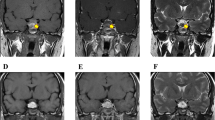Abstract
A 17-year-old boy was referred to our institution for a re-evaluation of congenital nephrogenic diabetes insipidus. A water restriction test revealed no urine concentration or volume reduction and a subsequent pitressin test revealed a lack of an anti-diuretic response. Nephrogenic diabetes insipidus was confirmed, and the patient was treated using trichlormethiazide 4 mg, indomethacin 175 mg, and desmopressin 20 μg. His blood pressure and weight were not controlled owing to polydipsia and polyuria secondary to acquired excessive water drinking behavior. Repeated admissions for weight control were necessary and despite consultation with a psychiatrist for his obsessive water drinking behavior, he had end-stage renal failure after 30 years of treatment. Genetic testing revealed AVPR2 mutation (c. T866C: p. L289P) that had previously been reported as a pathogenic mutation. His excessive drinking behavior persisted, leading to hyponatremia even after initiation of hemodialysis. There was also difficulty in achieving body weight control, which was managed by repeated admissions with restriction of water intake, being the mainstay of management.


Similar content being viewed by others
References
Bockenhauer D, Bichet DG. Nephrogenic diabetes insipidus. Curr Opin Pediatr. 2017;29(2):199–205.
Earley LE, Orloff J. The mechanism of antidiuresis associated with the administration of hydrochlorothiazide to patients with vasopressin-resistant diabetes insipidus. J Clin Investig. 1962;41(11):1988–97.
Berl T, Raz A, Wald H, Horowitz J, Czaczkes W. Prostaglandin synthesis inhibition and the action of vasopressin: studies in man and rat. Am J Physiol. 1977;232(6):F529.
Stokes JB. Integrated actions of renal medullary prostaglandins in the control of water excretion. Am J Physiol. 1981;240(6):F471.
Ryu HH, Chung JH, Shin BC, Kim HL. Congenital nephrogenic diabetes insipidus with end-stage renal disease. Korean J Intern Med. 2015;30(2):259–61.
Nakada T, Miyauchi T, Sumiya H, Shimazaki J. Nonobstructive urinary tract dilatation in nephrogenic diabetes insipidus. Int Urol Nephrol. 1990;22(5):419–27.
Mori T, Hosomichi K, Chiga M, Mandai S, Nakaoka H, Sohara E, Okado T, Rai T, Sasaki S, Inoue I, Uchida S. Comprehensive genetic testing approach for major inherited kidney diseases, using next-generation sequencing with a custom panel. Clin Exp Nephrol. 2017;21(1):63–75.
Arthus MF, Lonergan M, Crumley MJ, Naumova AK, Morin D, De Marco LA, Kaplan BS, Robertson GL, Sasaki S, Morgan K, Bichet DG, Fujiwara TM. Report of 33 novel AVPR2 mutations and analysis of 117 families with X-linked nephrogenic diabetes insipidus. J Am Soc Nephrol. 2000;11(6):1044–54.
Klahr S, Pukerson ML. The pathophysiology of obstructive nephropathy: the role of vasoactive compounds in the hemodynamic and structural abnormalities of the obstructed kidney. Am J Kidney Dis. 1994;23(2):219–23.
Uribarri J, Kaskas M. Hereditary nephrogenic diabetes insipidus and bilateral nonobstructive hydronephrosis. Nephron. 1993;65(3):346–9.
Onozaki A, Suzuki H, Imamura N, Katoh T, Watanabe T. Congenital nephrogenic diabetes insipidus with marked hyponatremia. Clin Exp Nephrol. 2001;5:265–7.
Boussemart T, Nsota J, Martin-Coignard D, Champion G. Nephrogenic diabetes insipidus: treat with caution. Pediatr Nephrol. 2009;24(1761–1763):4.
Ohzeki T. Urinary adenosine 3′,5′-monophosphate (cAMP) response to antidiuretic hormone in diabetes insipidus (DI): comparison between congenital nephrogenic DI type 1 and 2, and vasopressin sensitive DI. Acta Endocrinol (Copenh). 1985;108(4):485–90.
Acknowledgements
This study was funded by the Okinaka Memorial Institute for Medical Research.
Author information
Authors and Affiliations
Corresponding author
Ethics declarations
Ethics approval and consent to participate
This study was performed in accordance with the tenets of the Declaration of Helsinki and compliant with institutional review board guidelines. The patient gave informed consent for the publication of this case report.
Additional information
Publisher's Note
Springer Nature remains neutral with regard to jurisdictional claims in published maps and institutional affiliations.
About this article
Cite this article
Iijima, T., Mori, T., Sohara, E. et al. A patient with congenital nephrogenic diabetes insipidus due to AVPR2 mutation complicated by persisting polydipsia under hemodialysis treatment. CEN Case Rep 10, 226–229 (2021). https://doi.org/10.1007/s13730-020-00549-8
Received:
Accepted:
Published:
Issue Date:
DOI: https://doi.org/10.1007/s13730-020-00549-8




